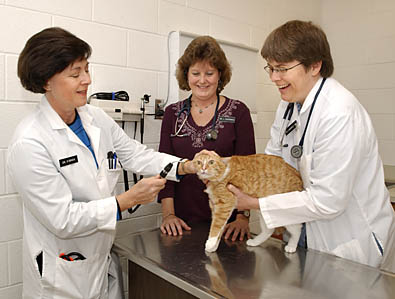Inside Iowa State | ||
Inside ArchivesSubmit newsSend news for Inside to inside@iastate.edu, or call (515) 294-7065. See publication dates, deadlines. About InsideInside Iowa State, a newspaper for faculty and staff, is published by the Office of University Relations. |
November 5, 2004 Teaching with practiceby Teddi Barron Grasping a short wooden pole with a paper cup at one end, Dr. Kim Langholz runs after Jack, an 11-year-old male Staffordshire bull terrier. The dog dashes from tree to tree and back again outside the entrance to the Small Animal Clinic at the Veterinary Teaching Hospital. Eventually, he finds his spot. Langholz positions the cup to catch the sample she needs for a urinalysis. Chasing dogs around trees isn't listed on any Iowa State employee job description. But it's all in a day's work for Langholz and Drs. Susan O'Brien and Lin Kauffman, the university's community practice veterinarians. Like any private practice, the community practice unit at Iowa State is a full-service, primary care clinic --with one distinction: it has a teaching mission. 
(From left) Drs. Susan O'Brien, Lin Kauffman and Kim Langholz examine a cat at the Small Animal Clinic at the Veterinary Teaching Hospital. On a typical day, the veterinarians see 10 to 14 animals. Photo by Bob Elbert. Mites and bitesLangholz, O'Brien and Kauffman teach veterinary students on rotation how to examine companion animals and diagnose and treat their everyday illnesses -- sniffles and sprains, tooth aches and ear aches, mites and bites -- that make up the bulk of a small animal veterinarian's practice. A 26-year veteran of the community practice clinic, O'Brien was the only community practice veterinarian at the clinic for many years. Kauffman joined the staff in May 2003; Langholz started in January of this year. In 2003-04, the community practice veterinarians saw 2,000 active, regular clients. On a typical day, they see an average of 10 to 14 clients. On this particular Monday morning, while dealing with Jack, the clinicians also oversee two dental cleaning check ups; a cat with a urinary tract infection; a kitten with multiple ailments, including a nasty case of ear mites; and a euthanasia. While a student takes the dog Jack to X-ray, Langholz heads for the medical treatment room. Crammed with exam tables, monitors, cabinets of medicines and instruments, the treatment room is a dynamic hub of the clinic. Students, doctors and veterinary technicians (distinguished by different color lab coats) hurry in and out, stopping to gently poke and prod their furry clients. An overwhelming sense of purpose permeates the room. Langholz readies Jack's urine sample for lab analysis, transferring it to a test tube, entering information into a computer and printing out a label. "Jack is an intact male and has bloody urine. The X-ray will show whether or not he has an enlarged prostate," explains Langholz. "We'll check the urine for evidence of infection and/or crystals." The symptom could be caused by stones in his bladder, inflammation, infection, prostate problems or cancer, she says. Later in the day, the X-ray shows Jack's prostate is enlarged. Langholz decides to recommend neutering to reduce Jack's testosterone level. Rinse and spitKauffman oversees the practice's dental patients. Because the animals must be anesthetized during dental radiographs and cleaning, the procedure can take up to two hours. Only two "dentals" are scheduled each week, both on Mondays. The number of dentals performed per week is limited by radiology's and aesthesia's other commitments to the teaching hospital, Kauffman said. Kauffman checks on two students performing a dental exam on Rex (not his real name), a 3-year old Weimaraner. He's on an IV and under gas anesthesia. One student monitors his blood pressure, heart and oxygen flow, while the other diligently cleans the dog's teeth, first de-scaling manually and then with an ultrasound plaque remover. Kauffman shows the student how to tackle a pesky ridge on the canine tooth with a dental scaler. She spots a worn area on a molar and notes it on Rex's dental chart as a place to watch in the future. Like O'Brien and Langholz, she moves seamlessly between teaching and practice. Dentistry is just one of the specialties Kauffman pursues. She also serves as the community practice theriogenologist (in training with Dr. Lawrence Evans). Theriogenology focuses on reproductive techniques like artificial insemination and cryopreservation (freezing) of canine semen. Dr. Evans has developed a regular clientele of theriogenology patients, mostly field trial dogs, coon hounds and show animals. Ames Animal Shelter workAfter checking on her other dental client -- a 12-year-old cat with a tooth that needs to be pulled, Kauffman takes a call on a phone in the hallway. It's about the upcoming euthanasia -- a 15-year-old Bichon with a history of biting. "The owner is moving into assisted living and can't take the dog, which came from a shelter and has lived in four different homes because of its biting problems," Kauffman said. "There's no typical day, and there's never a time when I have nothing to do," Kauffman said. "My favorite part is never knowing what the next day will bring, never being bored." The three clinicians continue to improve the community practice learning experience for students. They recently added a two-hour weekly work session at the Ames Animal Shelter. They're exploring ways to increase the number of daily clients to better replicate the pace of a private practice clinic. |
Community practice clinic294-4900 Hours:
Fees are comparable to fees charged by private practice veterinarians in the area. |
|
Ames, Iowa 50011, (515) 294-4111. Published by: University Relations, online@iastate.edu. Copyright © 1995-2004, Iowa State University of Science and Technology. All rights reserved. |
||